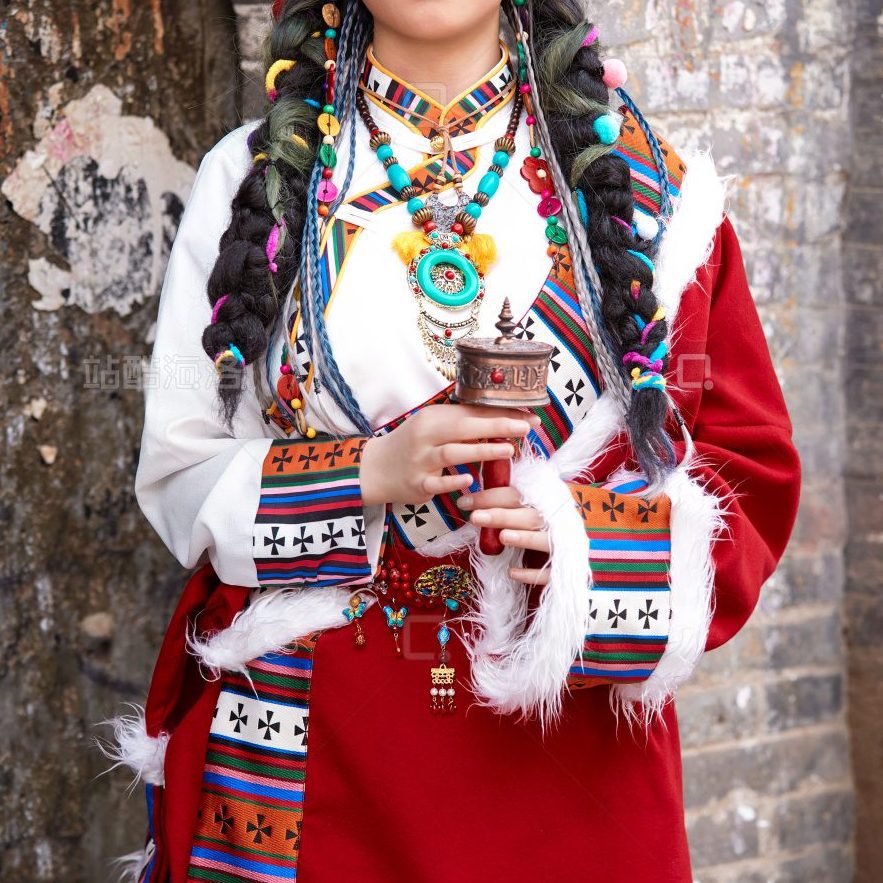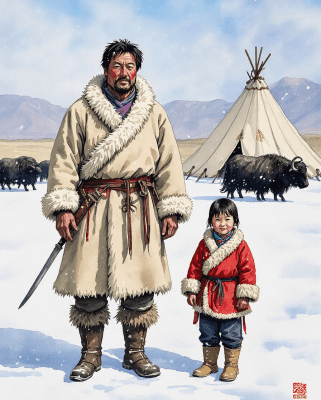Threads of the Sky: The Story Woven into Tibetan Attire

Imagine clothing forged by blizzards and scorching sun, where every stitch holds prayers and every color maps the cosmos. Tibetan dress isn’t fashion; it’s portable architecture, spiritual armor, and cultural DNA shaped over millennia on the “Roof of the World.” From nomadic survival to sacred symbolism, let’s unravel the fabric of Himalayan heritage and discover why its essence captivates global design today.
Chapter 1: Born from the Wind: Nomadic Roots & Functional Mastery (Pre-7th Century CE)
Survival above 4,000 meters demanded ingenious adaptation. Early Tibetan attire prioritized brutal pragmatism:
-
The Chuba: Life-Saving Layers:
This iconic robe (worn by all genders) was genius:
— Day: Worn with sleeves tied at the waist, allowing movement for herding.
— Night: Untied and elongated into a sleeping bag against sub-zero cold.
— Material: Sheepskin (fur inward for warmth), later yak wool (khullu), woven tightly for windproofing.
-
Functional Adornments:
— Leather Belts: Held essential tools – knives, flint, amulets.
— Ghamu (Boots): Thick felt soles insulated against frozen ground; yak leather uppers repelled mud.
-
Color & Status: Early dyes were rare. Natural undyed wool (browns, whites) dominated. Simplicity ruled.
Core Wisdom: Resilience through resourcefulness. Every element served survival in an extreme, beautiful landscape.
Chapter 2: Dharma in Thread: Buddhism’s Colorful Revolution (7th Century CE Onward)
With Buddhism’s arrival, clothing transformed into a canvas of cosmology and devotion:
-
The Pangden: Stripes of Identity & Sacred Geometry:
Women’s aprons became biographical tapestries:
— Colors: Blue (sky), white (clouds), green (water), red (fire), yellow (earth) – mirroring prayer flags.
— Symbols:
Swastika (eternal harmony)
Endless Knot (interconnectedness)
Precious Jewel (Buddhist teachings)
— Social Code: Stripes indicated region (e.g., wide red = Lhasa nobility).
-
Ritual Splendor:
— Monastic Robes: Deep maroon (madder root dye), symbolizing grounded spirituality.
— Festival Chubas: Elaborate brocades (often imported Chinese silk), fur trim, towering hats (Perak adorned with turquoise/coral for wealth).
-
Protective Adornments:
— Ga’u: Intricate silver amulet boxes worn around the neck or waist, holding sacred texts or relics.
— Yue (Turquoise) & Coral: Believed to ward off evil and attract health/fortune.
Core Wisdom: Beauty as sacred language. Garments became mobile mandalas, weaving faith into daily life.
Chapter 3: Modern Threads: Himalayan Heritage Meets Global Style
Tibetan aesthetics aren’t frozen in time. Designers worldwide are ethically reinterpreting its genius:
Why Tibetan Elements Captivate Modern Design:
-
Hero Materials:
— Khullu (Yak Wool): Sustainable, thermo-regulating, softer than cashmere. Perfect for eco-luxe scarves, throws, knitwear.
— Reclaimed Silks/Broades: Vintage textiles repurposed with reverence.
-
Symbols with Soul:
— Abstracted Motifs: The Endless Knot as a modern pendant; subtle Swastika geometry in weaving (strictly as cultural pattern).
— The Ga’u Reborn: As minimalist lockets or statement belt buckles, holding personal talismans.
-
Color Alchemy:
— Earth & Sky Palette: Deep indigos, fiery rusts, spiritual saffrons – inherently grounding and bold.
— Pangden Stripes: Reimagined as accent trims on sleeves, bag straps, or ceramic glazes.
-
Craft with Conscience: Supporting Tibetan artisan cooperatives preserves skills and uplifts communities.
Wearing the Mountain Spirit:
Choosing Tibetan-inspired pieces connects you to:
-
Ancient Resilience: Yak wool scarves embody survival-turned-luxury.
-
Sacred Geometry: A ga’u-inspired pendant isn’t just jewelry; it’s a personal sanctuary.
-
Color Magic: Pangden-hued accessories carry the vibrancy of Himalayan festivals.
-
Slow Craft: Hand-woven textiles honor patience and skill in a fast world.




Reading this felt like discovering hidden treasure! The way Tibetan clothing blends survival wisdom with sacred artistry is mind-blowing. I recently purchased a yak wool scarf mentioned in Chapter 3 – wearing it feels like wrapping myself in Himalayan resilience. The khullu wool is miraculously soft yet insanely warm, like wearing a cloud that remembers mountains.
What truly captivates me is how every piece tells stories. My scarf’s subtle Pangden-inspired stripes aren’t just patterns; they carry centuries of sky-and-earth symbolism. Learning how the Chuba transforms from robe to sleeping bag (genius!) makes me appreciate the profound practicality woven into each stitch.
And that Ga’u pendant? Mine holds a tiny peace mantra – it’s become my modern amulet. This isn’t fast fashion; it’s slow, soulful craft connecting me to artisans who turn devotion into fabric.
For anyone craving clothing with meaning, these pieces deliver. They transition beautifully from city streets to mountain trails, sparking conversations about culture everywhere I go. Ethical, breathtaking, and deeply grounding – wearing Tibetan heritage makes you feel part of something ancient and alive.